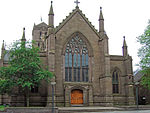Steeple Church

The Steeple Church occupies the western part of the historic "City Churches" building in Dundee, Scotland. It is a congregation of the Church of Scotland. The "City Churches" are located in the city centre, adjacent to the Overgate shopping centre. The building is unusual as having two congregations within the same structure – the other congregation (at the eastern end) is Dundee Parish Church (St Mary's). The middle building ceased functioning as a place of worship in the early 1990s. St Mary's Tower, the clock tower at the western end of the City Churches, is the oldest part of the church, and is currently operated by Dundee City Council's heritage department and is commonly referred to as the Old Steeple by locals. During the war between Scotland and England known as the Rough Wooing, Dundee and Broughty Castle were occupied by English forces. In January 1548, an English commander, Thomas Wyndham placed a garrison of 20 "tall men" in the steeple, with the help of Andrew Dudley and the Scottish Lord Gray. Their armaments included cannon described as "a saker and a falcon and four double bases" and small guns called "hackbuts of crook".
Excerpt from the Wikipedia article Steeple Church (License: CC BY-SA 3.0, Authors, Images).Steeple Church
Nethergate, Dundee City Centre
Geographical coordinates (GPS) Address External links Nearby Places Show on map
Geographical coordinates (GPS)
| Latitude | Longitude |
|---|---|
| N 56.4594 ° | E -2.973 ° |
Address
The Steeple Church
Nethergate
DD1 4EL Dundee, City Centre
Scotland, United Kingdom
Open on Google Maps









